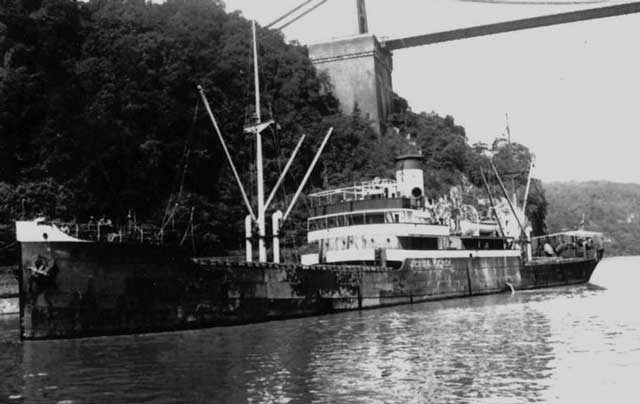Saturday 7 February 1942
 |
| The Saturday Evening Post (Feb. 7, 1942), cover by Norman Rockwell – Willie Gillis at the U.S.O. (1942) - Curtis Publishing Company. |
 |
| "The pilots' instrument panel and flight controls of a Short Stirling Mk I of No. 7 Squadron RAF at Oakington, Cambridgeshire, February 1942." © IWM (CH 17086). |
The United States Army Air Force 5th Air Force, which now controls operations in the southwest Pacific, continues to build up its presence on Java in the Netherlands East Indies. Today, four more P-40s fly from Australia and make it to Blimbing Airdrome. The USAAF command at Singosari Aerodrome on Java sends nine B-17 Flying Fortress bombers to attack shipping at Balikpapan, but they are met by Japanese fighters and driven off.
The Allies in the Bataan Peninsula, the Philippines, mount a determined attack on the Japanese pockets (the Big Pocket and the Little Pocket) just south of the Main Line of Resistance (MLR). These pockets are in the western portion of the line controlled by the I Corps, which sends the 92d Infantry of the 91st Division of the Philippine Army against them. Further south, other Philippine troops make good progress against the remaining Japanese trapped at Quinauan Point. USAAF P-40s drive off a Japanese seaborne attempt from Olongapo to reinforce and supply these and other trapped units in the South Sector.
 |
| An Italian C.R. 42 fighter that was forced to land during an encounter with RAF fighters near Sollum, Libya on 7 February 1942. |
 |
| USS Concord (CL-10) at the Mare Island Navy Yard, 7 February 1942. Note the obsolete casement guns. |
 |
| British freighter Jessie Maersk, sunk by German E-boats on 7 February 1942. |
German E-boats intercept and sink 1972-ton British freighter Jessie Maersk while traveling north from London to Blyth. There are 20 deaths.
While being refitted as a refrigerated banana boat in Halifax Harbor, 3250-ton MV Maurienne catches fire and capsizes. She is later refloated and returned to service.
 |
| Actress Loretta Young on the cover of Picturegoer Magazine [United Kingdom] (7 February 1942). |
 |
| Rickard, J (3 February 2018), USS Portland (CA-33) at Mare Island, 7 February 1942 (History of War). |
Donald M. Nelson, the new Chairman of the Office of Production Management, officially orders United States automakers to cease production of domestic passenger cars. Their factories henceforth will manufacture military items. Nelson's office guarantees the automakers' profits over and above their expenses. This offer includes a promise to sell to the auto manufacturers the $11 billion worth of new manufacturing plants to be built during the war at a steep discount after the war is won. The few automakers still making cars continue those already on the production line, with the last new cars finished on 10 February 1942.
Latin America: Uruguay defeats Argentina 1-0 to win the South American Championship of football in Montevideo. This is Uruguay's eighth title.
 |
| The symbol for the Double V campaign in the Pittsburgh Courier that begins on 7 February 1942. |
American Homefront: Glenn Miller and His Orchestra hit No. 1 on the Billboard Best Sellers chart with "String of Pearls," recorded on 8 November 1941 in New York City. This is the second of four No. 1 hits that Miller and his band achieve in 1942, the other three being "Chattanooga Choo Choo" in January, "Moonlight Cocktail" from late February to early May, and "(I've Got a Gal in) Kalamazoo" during September and October. While it has a long way to go, the Big Band era may be said to peak in 1942.
The "Double-V" campaign begins. This is a special symbol adopted within the African-American community to denote the twin goals of fighting fascism overseas and conditions at home in the United States. The symbol first appears in the African-American newspaper Pittsburgh Courier on February 7, 1942. The campaign continues weekly in the Pittsburg Courier, which is the most circulated black newspaper with a national circulation of around 200,000 subscribers, until 1943.
 |
| Pittsburgh Courier on February 7, 1942, showing the Double-V symbol. |
February 1942
February 1, 1942: The US Navy Strikes Back
February 2, 1942: Germans Recovering in Russia
February 3, 1942: Japanese Shell and Bomb Singapore
February 4, 1942: Battle of Makassar Strait
February 5, 1942: Empress of Asia Sunk
February 6, 1942: The Christmas Island Body
February 7, 1942: The Double-V Campaign
February 8, 1942: Japan Invades Singapore
February 9, 1942: French Liner Normandie Capsizes
February 10, 1942: US Car Production Ends
February 11, 1942: Tomforce Fails on Singapore
February 12, 1942: The Channel Dash
February 13, 1942: Japanese Paratroopers In Action
February 14, 1942: RAF Orders Terror Raids
February 15, 1942: Japan Takes Singapore
February 17, 1942: Indian Troops Defect to Japanese
February 18, 1942: Battle of Badung Strait
February 19, 1942: FDR Authorizes Internment Camps
February 20, 1942: O'Hare the Hero
February 21, 1942: Crisis in Burma
February 22, 1942: Bomber Harris Takes Over
February 23, 1942: Bombardment of Ellwood, California
February 24, 1942: US Raid on Wake Island
February 25, 1942: Battle of Los Angeles
February 26, 1942: Gneisenau Eliminated
February 27, 1942: Battle of Java Sea
February 28, 1942: Battle of Sunda Strait
2020
No comments:
Post a Comment